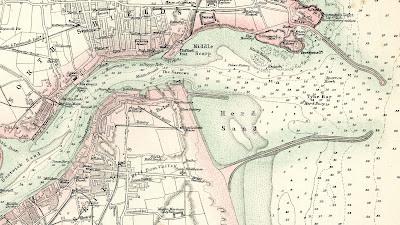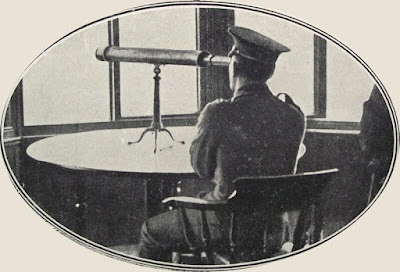 |
| Frenchmans Point Source: South Tyneside Council |
Frenchmans Bay lies on the coast 2,700 metres east of the mouth of the River Tyne in South Shields. It was the location of a coastal artillery battery which was operational in the First and Second World Wars.
As the 19th century approached it’s last decade the guns in the coastal batteries in Tynemouth were becoming obsolete. In 1845 construction of the Tyne Piers commenced and they took 50 years to build. When work was completed in 1895, they rendered the guns at Cliffords Fort North Shields , the mainstay of defence of the Tyne, obsolete.
 |
| River Tyne 1895 |
The obsolescence of the defences on the Tyne necessitated the building of more modern batteries and work commenced in 1899 at Tynemouth and South Shields.
Two batteries for 2 x 6inch and 1 x 9.2 inch naval guns were completed in 1903. Tynemouth Castle Battery on the north side, and Frenchman’s Point on the southside on the coast at South Shields. The Tynemouth Spanish Battery augmented the defences with 2 x 6 inch and 2 x 12 pounder quick firing naval guns. Cliffords Fort became a Submarine Mine Depot and a headquarters for the Tyne Electircal Engineers (TEE) who manned searchlights.
The 3rd Durham Volunteer Artillery, re-designated 3rd Durham Royal Garrison Artillery (Volunteers) in 1899, were the local volunteers who trained on the guns at the Frenchmans Point battery.
 |
| Frenchmans Point Battery 9.2 in gun BC 3rd Durham RGA |
 |
| Frenchmans Point Battery BC 3rd Durham RGA |
Frenchmans Point Battery was visited by Lord Roberts, Commander in Chief of the Forces, in June 1903 when he toured the boroughs of Tynemouth and South Shields.
Shields Gazette 25th June 1903
Source: http://www.thessvlbhistory.co.uk/History/1903events.htm
Crowds of people were assembled all along the route, but there was very little cheering. On arrival at the fort the Commander-in- Chief was met by Colonel Penin, commanding the Militia and Volunteer Artillery of the N.E. District, and Col. Dawson, commanding 3rd D.V.A., who are encamped near the fort. The guns were manned by the men of the 3rd D.V.A., under Capt. Bell, with Captain Armstrong and Lieut. Chapman as gun group commanders. His lordship made an inspection of the guns and witnessed some interesting practice from the 1-inch aiming tube. He also visited the volunteer camp and partook of refreshments in the officers' mess, where he met the officers of the corps. Here he took a cordial leave of them, and entering his carriage again was driven away, the Mayor and Mayoress accompanying him to the South Shields station.
 |
| Frenchmans Point Battery 1903 |
 |
| 1st East Riding RGA Camp Frenchmans Bay 1905 |
 |
| Tyne Defences 1914 |
In addition to the coastal artillery and submarine mines, the Royal Navy dedicated a scout cruiser and 14 destroyers of the 9th Destroyer Flotilla to defending the Tyne
 |
| HMS Patrol 9th Destroyer Flotilla |
The 1914 Station of Units shows the defences manned by 12 and 47 Companies of the Royal Garrison Artillery, augmented by the Tynemouth RGA (TF).
 |
| Watching the Tyne 1914 Source: Rickard, J (23 June 2014), Watching the mouth of the Tyne, 1914 http://www.historyofwar.org/Pictures/pictures_watching_tyne_1914.html |
An account of the operation of the Frenchman points Battery was recorded by 2nd Lieut. Leslie Tilley who was posted to the Tynemouth RGA in December 1914.
 |
| 9.2 inch gun Frenchmans Point Battery |
“I was posted to the Frenchman’s Point Battery, at Trow Point in South Shields. This had two six-inch guns covering Tynemouth and a 9.2-inch gun at the southern end of the position.
“We also knew the plan for a navigational ‘box’, set up a mile and a half offshore. This had been worked out before the war. All vessels wishing to enter the Tyne were to anchor there to be boarded by the crew of an examination steamer. All this took place under the gaze of the 6 inch guns at Spaniard’s Point under Tynemouth Castle. In the event of a ship behaving suspiciously, a single warning shot was allowed. If this was ignored, all guns in range would let fly".
"In those early days we were subjected to almost daily battery drills, including the use of searchlights and floodlights, test firings and security exercises, until we could have carried them out as we slept."
1914: “DEFENDING THE TYNE”
The naval threat to the British coastline from the Germany materialised in December 1914, though not on the Tyne. Four battle cruisers and two flotillas of destroyers bombarded the coastal towns of Scarborough, Whitby and Hartlepool.
With the conclusion of the First World War and the defeat of Germany, the threat to the UK coastline diminished. The German High Fleet had been scuttled at Scapa Flow in June 1919 and no other power was capable of challenging the Royal Navy in Europe.
In 1922 cracks started to appear in the Frenchmans Point gun emplacements as a result of mining subsidence. The cost of repairs was considerable, and with no real threat, the guns were dismounted and the land sold off.
Following the German invasion of Poland, in September 1939, Britain declared war on Nazi Germany. The Armed Forces mobilised and the British Expeditionary Force (BEF) deployed to the European Continent. Following the evacuation of the BEF from at Dunkirk May / June 1940, Britain prepared to defend the country against invasion. A Home Defence Executive was formed, and General Alanbrooke appointed Commander in Chief Home Forces.
As part of the anti-invasion measures, 153 Emergency Coatal Batteries were constructed along the coastline. The old emplacements at Frenchmans Point were brought back into use and two 6 inch naval guns installed. Another battery was built on The Lawe, above the mouth of the Tyne, with two 6 inch naval guns manned by Royal Marines.
 |
| Tyne Defences 1940 |
In March 1941, the six inch guns from Frenchmans Point replaced the guns at the Lawe Park Battery and the Tynemouth Territorials took over from the Royal Marines. Three 4.7inch guns were installed in new emplacements constructed at Frenchmans Point.
 |
| Frenchmans Point Battery Source: Victorian Forts |
 |
| Frenchmans Point Battery 1947 |





























